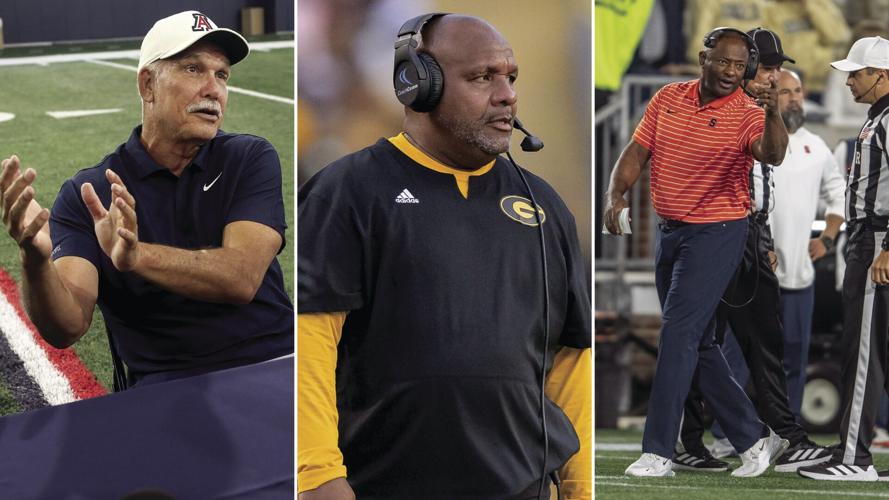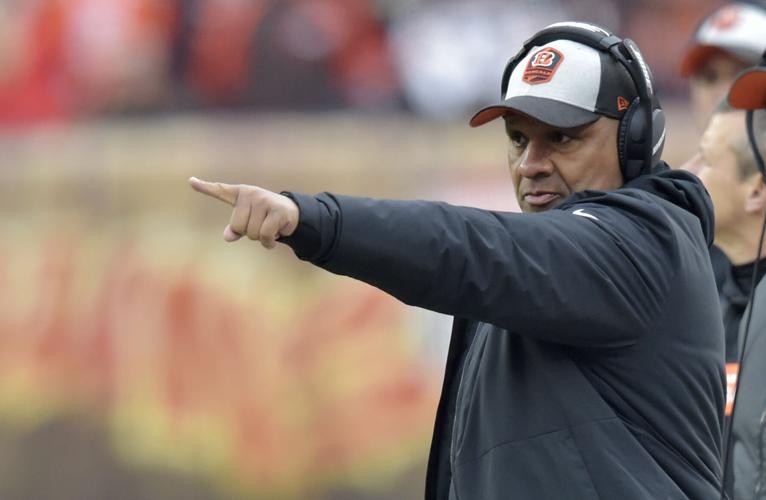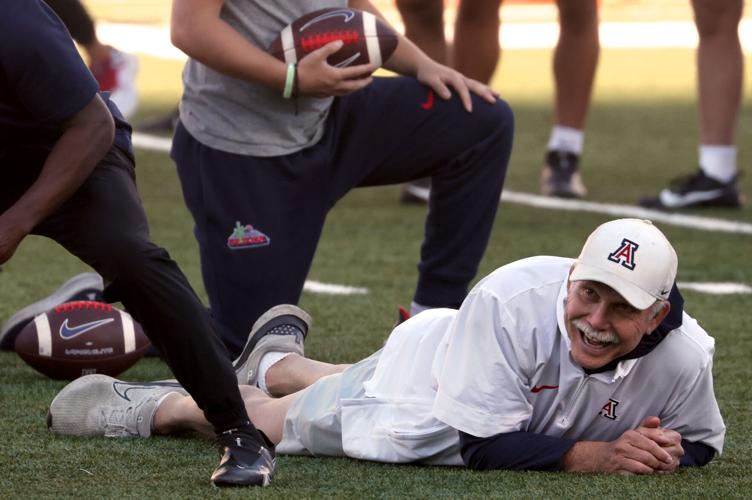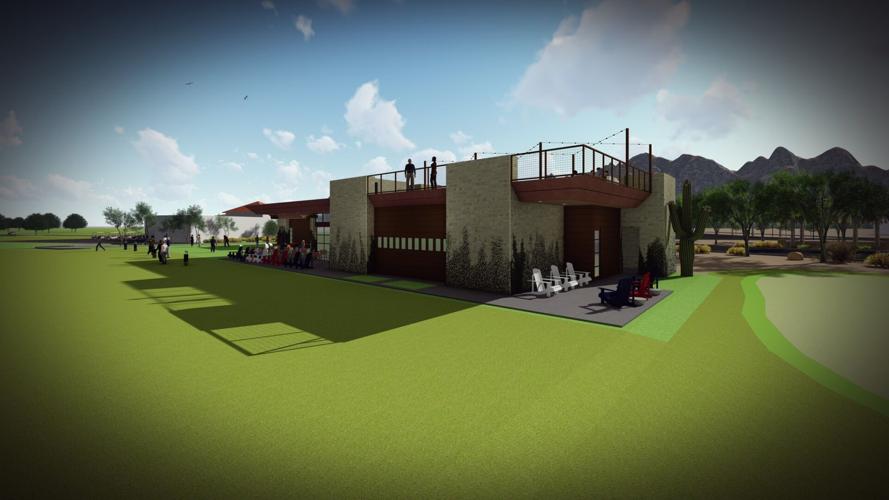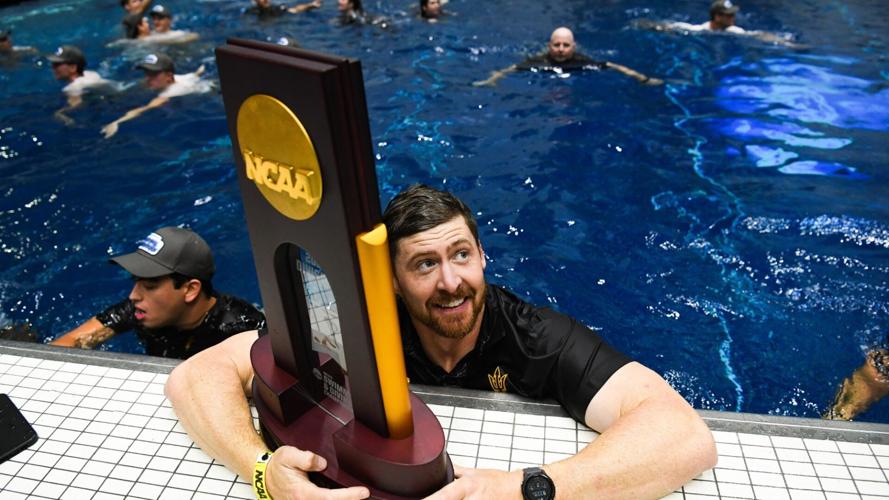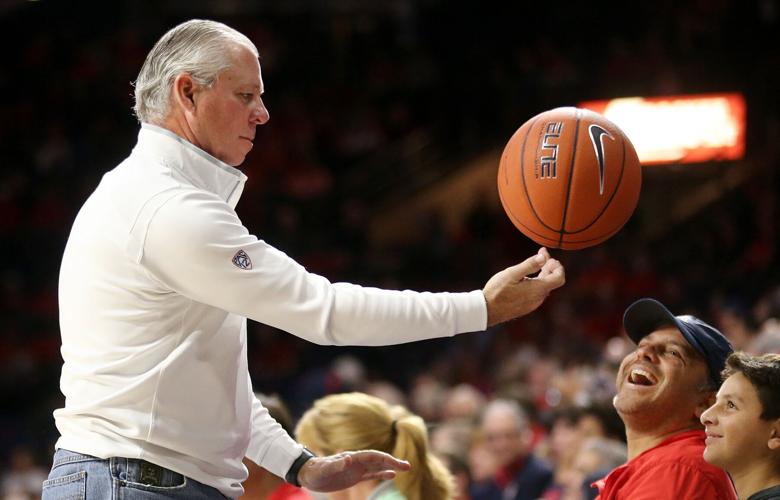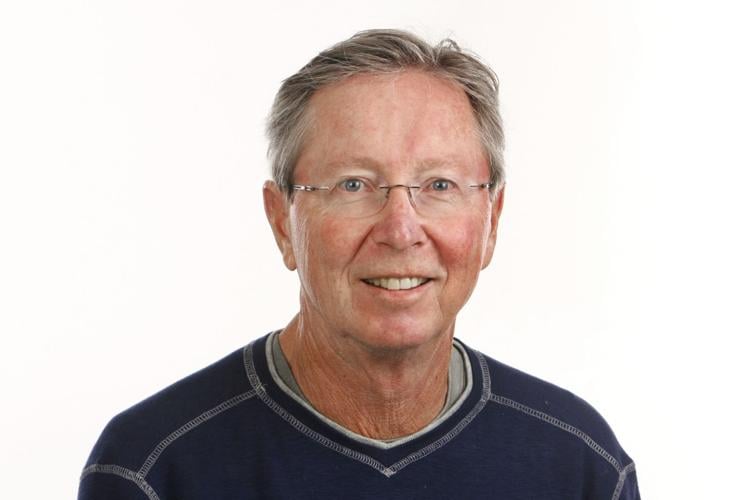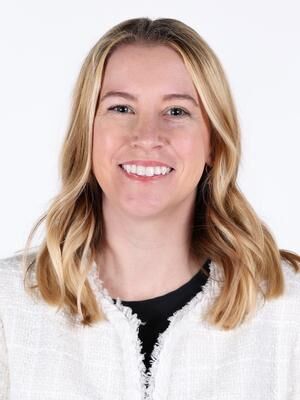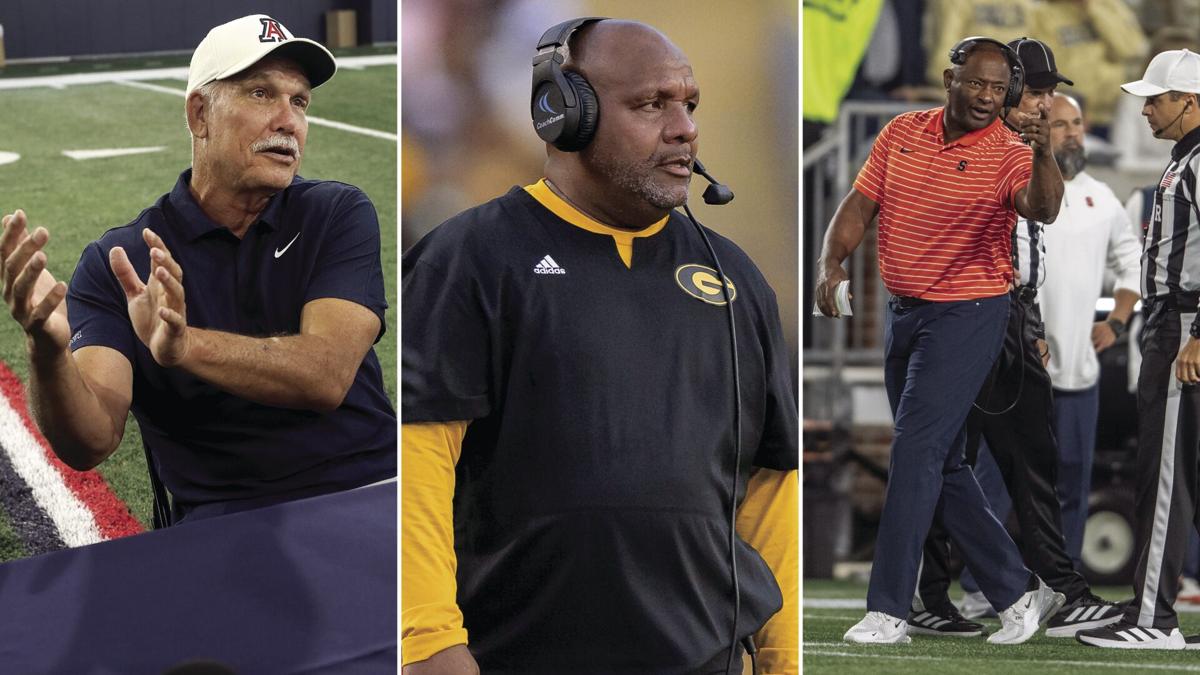The Star's longtime columnist on Arizona football's connection to the sport's statesmen of coaching, the near-debut of UA's game-changing golf complex, Tucson's Herbie Behm taking over ASU's national champion swim program, and the blessing and curse of outgoing UA President Bobby Robbins' sports fandom.

Greg Hansen is the longtime sports columnist for the Arizona Daily Star and Tucson.com
Survivors of a transient profession on display for Arizona football, local prep coaches
Eighteen of the Pac-10’s 20 offensive and defensive coordinators from the 2000 football season have retired or are inactive; many of them are big names with big accomplishments, such as Oregon’s Nick Aliotti, Stanford’s Kent Baer and WSU’s Bill Doba.
The two still active: once-and-again Arizona offensive coordinator Dino Babers and Fresno State head coach Jeff Tedford, who in 2000 was Oregon's offensive coordinator.
Babers and another from that group, Hue Jackson, joined Arizona's Duane Akina, at different points a defensive and offensive coordinator for Arizona in the 1990s, Friday at the UA's Lowell-Stevens Football Facility, reunited for Brent Brennan’s first coaching clinic.

Cincinnati Bengals special assistant to the head coach Hue Jackson points during the first half of an NFL football game against the Cleveland Browns, Sunday, Dec. 23, 2018, in Cleveland. (AP Photo/David Richard)
They are survivors in a transient profession.
Since the 2000 season, Babers now 62, Akina, 67, and Jackson, 58, have transitioned from rising stars in the profession to elder statesmen who have coached at a combined 15 jobs over those 23 seasons: Babers returned to Tucson this year after being the head coach at Syracuse, Bowling Green and Eastern Illinois, along with other roles at Baylor, UCLA, Pitt and Texas A&M. Akina returned to Tucson after elite-level jobs at Stanford and Texas.
Jackson? Not only has he been the head coach of the Cleveland Browns and Oakland Raiders, but most recently the head coach at Grambling State. Since leaving USC in 2000, Jackson has also coached for the NFL’s Bengals, Ravens, Falcons and at Tennessee State. He is not coaching this season for the first time since he began in 1986 at Pacific.
I bring this to your attention not just because Babers and Akina are, in my opinion, the top coordinator tandem at Arizona since they left in 2000 — Rich Ellerson was then Arizona’s defensive coordinator — but because Brennan was smart to pick Jackson to be the guest voice at his first UA coaching clinic.

Syracuse head coach Dino Babers walks back to the sideline during the second half of an NCAA college football game against Florida State, Saturday, Oct. 14, 2023, in Tallahassee, Fla. (AP Photo/Phelan M. Ebenhack)
It’s not the way Jedd Fisch did business, and that’s a good thing. Fisch would oversell his spring coaching clinic with his NFL acquaintances, bringing in the Rams’ Sean McVay, the Patriots’ Bill Belichick, the Bengals’ Zac Taylor, the Falcons’ Mike Smith and other big names such as Steve Spurrier, Brian Billick and on and on.
I found it disconcerting that Fisch couldn’t resist the opportunity to showcase his NFL résumé rather than make his coaching clinics about the high school football and youth coaches in the audience.
Brennan said last week that he chose Jackson to be the only “name’’ coach at his two-day clinic in order to spend more “face time with high school coaches and start building our relationships with them.”
This isn’t to suggest that Fisch’s approach didn’t work. It did. He recruited expertly, surrounded himself with quality assistant coaches and went from 1-11 to 10-3 in two years. He also led the league in name-dropping, which got old after a while.

Arizona defensive coordinator Duane Akina gets low to keep out of the way and watch his secondary unit defend passes as the Wildcats work out at Arizona Stadium during a spring practice session Tuesday.
There’s more than one way to recruit effectively and build a winner at Arizona, and both Babers and Akina have succeeded going opposite of Fisch's method of me-first. Babers, for instance, has quietly recruited more than 80 players who reached the NFL. That’s preferable to Fisch posing for pictures with Tedy Bruschi and Rob Gronkowski.
And Akina’s résumé is as good as it gets. He has coached three Jim Thorpe Award winners, including Arizona’s Darryll Lewis, and seven consensus All-American defensive backs, including Arizona’s Chris McAlister.
Fisch titled his coaching clinics “Be a Pro.’’ Brennan doesn’t have a catchy nickname for his clinic, although judging from Jackson’s accomplishments,, a fitting title would be “How To Succeed As A Coach.’’

The new Clements Golf Complex at Tucson Country Club (depicted in renderings) will serve the University of Arizona's women's and men's golf programs.
Arizona golf complex among best
Thanks to 1960s UA baseball/basketball standout Nyal Leslie, a key operative in the Tucson Country Club’s decision to be the site of Arizona’s $14.5 million Clements Golf Complex, I was able to tour the 7,000-square foot facility during the UA’s recent victory in the Arizona Thunderbirds Intercollegiate at TCC.

The new Clements Golf Complex at Tucson Country Club (depicted in renderings) will serve the University of Arizona's women's and men's golf programs.
I have one word for the first true home for Arizona’s men’s and women’s golf programs since leaving Arizona National about 20 years ago: Wow.
Ribbon-cutting for the Clements Complex is expected later this month — not long after coach Jim Anderson’s 11th-ranked men’s team plays at No. 4 ASU in a 20-team event at the Sun Devils’ $18 million Papago Golf Club practice area. The Phil Mickelson-blessed Papago facility, which opened in 2018, hailed as the top college golf complex outside those at SEC and ACC powerhouses.
Now the UA complex ranks with anyone, anywhere. The chipping practice area is world-class. Coaches offices, players locker rooms, workout areas and study rooms are state of the art. The software used for putting analytics and shot-tracking are at PGA Tour levels.
Arizona has won four NCAA golf championships since 1992 (three for the women) and have done so mostly with no home base. The UA’s former coach, Hall of Famer Rick LaRose, was a driving force in helping get the TCC complex built.
“We had the right people at the right time,’’ said Leslie. “It took us four years, beginning to end, to get this done. I think it’s as good as it gets.’’
Tucsonan Behm new boss for ASU swim champs
Herbie Behm was Tucson’s 2008 high school swimmer of the year at Catalina Foothills High School, who chose to swim at Tennessee instead of joining Frank Busch’s 2008 NCAA championship team at Arizona.
It didn’t work out for Behm at Tennessee, so he transferred to ASU, which in 2010 announced it would eliminate its swimming programs. But ASU donors contributed $1.4 million to save the Sun Devils swimming program and now, 14 years later, ASU is on top. It won last week’s men’s national championship.
Alas, head coach Bob Bowman left 48 hours later to become head coach at Texas. Behm, who had been Bowman’s top assistant the last five years, was named head coach. Talk about a rare move.

Tucson native Herbie Behm, the 2008 high school swimmer of the year at Catalina Foothills, recently helped ASU win the 2024 NCAA Division I men’s swim and dive championship as a Sun Devil assistant coach. Behm was promoted just days later to head coach of the ASU men’s and women’s programs.
Over the last 100 years, Tucson High state champ and UA consensus tennis All-American Bill Lenoir became the first Tucsonan to be a head coach at ASU, taking over the men’s tennis team from 1968-71. In 2001, Sunnyside High state wrestling champ Thom Ortiz became ASU’s head wrestling coach for eight years, followed by another Tucsonan, Santa Rita state champ Shawn Charles, from 2009-14. Ortiz and Charles both wrestled at ASU.
A reverse move — ASU to UA — hasn’t been as high-profile. Yes, Mike Candrea graduated from ASU before winning eight NCAA softball championships at Arizona. And yes, former ASU head football coach Ed Doherty became Arizona’s head coach, 1957-58, and later Salpointe Catholic’s head coach, 1978-82.
That’s about it. Jumping from Tucson to Tempe, or vice-versa, has been rare. Although there’s this: Nick Kerr, the son of Arizona icon Steve Kerr, is the head coach of the NBA G League’s Santa Cruz Warriors. This year, he hired ex-Sun Devils basketball assistant coach Brandon Rosenthal, a graduate of Catalina Foothills High School.
So maybe Sun Devils and Wildcats can work together.
Short stuff: Like father, like sons for Tucson's football Fina fam
• Tucsonan John Fina, an 11-year NFL veteran from Salpointe who was a first-round draft pick at Arizona in the spring of 1992, is a proud papa and then some. His oldest son, Bruno Fina, started 13 games at left tackle at UCLA last season and has two seasons of eligibility left for the Bruins as they head to the Big Ten. John’s younger son, Roman Fina, a senior-to-be at Salpointe, has recently received recruiting offers from Duke, Penn and Dartmouth. A week ago, John took a photo while standing behind Roman. You couldn’t see John behind the 6-4⅓, 250-pound Salpointe prospect. Like father, like sons. ...

Morgan Domenick
• Arizona athletic director Desireé Reed-Francois didn’t waste much time in reworking her administrative staff. Last week, she hired Morgan Domenick, Missouri’s associate athletic director for administration for a similar job at McKale Center. Domenick is seen as a rising star in college athletics administration. After playing tennis at Boise State — same place as UA men’s tennis coach Clancy Shields — Domenick attended LSU’s law school and then worked in the athletic departments at Southern Miss and Syraucse before Mizzou. Domenick is part of a sports family. Her husband, Korey Domenick, was a first baseman on West Florida’s NCAA Division II national championship team of 2011.
Numbers of the week: Skaggs' fielding prowess; Men's hoops NIL fortunes
• Arizona center Oumar Ballo finished the basketball season with a 49.5 free throw percentage. According to my research, he is only the third UA starter in 50 years to finish below 50%. The others: Aaron Gordon, 42.2 in 2014 and Joseph Blair 40.0 in 1996. It doesn’t mean Ballo won’t improve. Gordon has shot 68.2% in his fruitful NBA career. ...
• The San Diego Union-Tribune last week reported that Arizona senior basketball forward Keshad Johnson reportedly was paid $400,000 in NIL money to transfer to Arizona. I don’t know if that’s fully accurate, but I believe it’s not out of the ballpark. I have been told that the NIL program supporting Arizona men's basketball received $25,000 from 40 donors last year to use to shore up Tommy Lloyd’s roster. That’s $1 million. Use your imagination. ...

Arizona's second baseman Allie Skaggs (9) gets a generous hop to throw out Utah Tech's Laura Lockard (25) in the fourth inning of the Wildcats’ season opener at Hillenbrand Stadium on Feb. 8.
• Arizona softball second baseman Allie Skaggs was the national Defensive Player of the Year in 2023 when she committed no errors in 168 total chances. That’s hard to believe. This year Skaggs has committed three errors in 123 chances, including one in Friday’s 10-8 victory over Utah. But the statistic that counts is that Skaggs has a .989 fielding percentage the last two seasons in 291 chances. Amazing. ...
• Salpointe beach volleyball coach Heather Moore-Martin, who has coached nine state championship volleyball teams the last 15 years, enters the final week of the regular season with a 60-match winning streak as a team, and a win streak of 295 in pairs competition. The Lancers finish the regular season against Marana on Thursday and are strong favorites to win a fourth consecutive state championship. It’ll be senior day this week for Salpointe senior Megan Muehlebach, daughter of former Arizona starting point guard Matt Muehlebach. Megan plays on the No. 1 pairs team, her sister, Kiki, a sophomore, is on the No. 2 pairs team. Talk about good genes.

University of Arizona president Robert Robbins flashes his ball-handling skills during a break in action during the first half of the Arizona Wildcats’ men’s basketball exhibition matchup against the Chaminade Silverswords on Nov. 4, 2018, at McKale Center.
My two cents: UA president's sports fandom a blessing, curse?
Bobby Robbins has been one of the few Pac-12 presidents passionate about college athletics, which can be a blessing and a curse.
The blessing: Robbins didn’t deny athletic director Dave Heeke the funds to spend more than $100 million on facility improvements at Arizona Stadium, Hillenbrand Stadium, Hi Corbett Field, McKale Center and for the school’s $12 million of improvements at the Hillenbrand Aquatics Center and $14.5 million for a new golf complex at Tucson Country Club.
The curse: if something outside athletics goes wrong on the main campus, as it did with the UA’s financial crisis, you probably cannot survive. Ultimately, it became a “this is your mess’’ situation, one that Robbins first blamed on Heeke, firing him, but in the long run, Robbins lost his job, too, announcing this week he'll step down as soon as the Arizona Board of Regents hire his replacement or in 2026 at the end of his contract — whichever comes first.

University of Arizona president Robert Robbins gives UA freshman guard Skylar Jones a high five after the Wildcats' spirited effort in a 95-93 double-overtime loss against No. 7 USC at McKale Center on Feb. 29.
With Robbins soon to be gone, the UA has little hope to rebuild the 95-year-old west side of Arizona Stadium, which is the worst of all Pac-12 football stadiums. It might be 15 or 20 years until a new UA president has the courage to ask for $300 million (or more) to tear down the west-side seats.
When Robbins was hired in 2017, the other finalist for the job was ASU’s Sethuraman Panchanathan, then the Sun Devils’ Chief of Research and Innovation, a man said to be responsible for more than quadrupling ASU’s income for research from $110 million to $550 million annually.
Panchanathan left ASU in 2020 to become the director of the U.S. Natural Science Foundation, a position that required “Panch’’ to be confirmed by the U.S. Senate.
Oops. In retrospect, the Arizona Board of Regents might’ve goofed on that hire.
VIDEO: At a press conference introducing her as the University of Arizona's new athletic director on Tuesday, Feb. 20, 2024, Desireé Reed-Francois gives her introductory remarks after being introduced by UA president Robert Robbins. (Courtesy Arizona Athletics)


